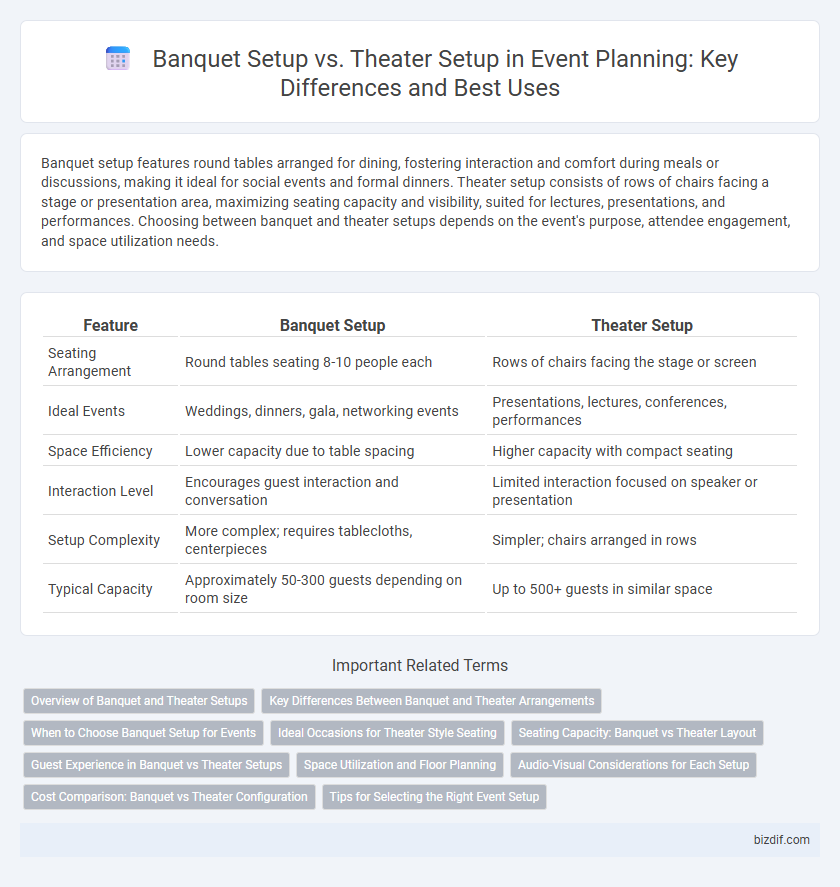Banquet setup features round tables arranged for dining, fostering interaction and comfort during meals or discussions, making it ideal for social events and formal dinners. Theater setup consists of rows of chairs facing a stage or presentation area, maximizing seating capacity and visibility, suited for lectures, presentations, and performances. Choosing between banquet and theater setups depends on the event's purpose, attendee engagement, and space utilization needs.
Table of Comparison
| Feature | Banquet Setup | Theater Setup |
|---|---|---|
| Seating Arrangement | Round tables seating 8-10 people each | Rows of chairs facing the stage or screen |
| Ideal Events | Weddings, dinners, gala, networking events | Presentations, lectures, conferences, performances |
| Space Efficiency | Lower capacity due to table spacing | Higher capacity with compact seating |
| Interaction Level | Encourages guest interaction and conversation | Limited interaction focused on speaker or presentation |
| Setup Complexity | More complex; requires tablecloths, centerpieces | Simpler; chairs arranged in rows |
| Typical Capacity | Approximately 50-300 guests depending on room size | Up to 500+ guests in similar space |
Overview of Banquet and Theater Setups
Banquet setups feature round tables arranged to encourage dining and conversation, ideal for meals and social interaction during events. Theater setups consist of rows of chairs facing a single direction, optimized for presentations, lectures, or performances where audience focus is directed at a stage or speaker. Each arrangement supports different event goals, with banquet setups fostering engagement and theater setups maximizing seating capacity and visibility.
Key Differences Between Banquet and Theater Arrangements
Banquet setup features round tables with chairs arranged for dining, promoting social interaction and ease of serving food, while theater setup consists of rows of chairs facing a stage, designed for maximizing seating capacity and audience focus on presentations. Banquet arrangements prioritize comfort and accessibility for meal service, whereas theater setups emphasize visibility and efficient use of space for lectures or performances. These key differences impact event flow, guest experience, and logistical requirements such as catering and audiovisual equipment placement.
When to Choose Banquet Setup for Events
Banquet setup is ideal for events requiring dining and social interaction, such as weddings, gala dinners, and corporate luncheons, where guests need space for meals and conversation. This arrangement uses round tables that encourage engagement and comfort, supporting activities like presentations with meal service or group discussions. Choosing banquet setup enhances event flow when food service is central and close guest interaction is desired.
Ideal Occasions for Theater Style Seating
Theater style seating is ideal for presentations, lectures, and conferences where audience focus is directed towards a single speaker or stage, maximizing the number of attendees in limited space. Unlike banquet setups that encourage social interaction and dining, theater setups prioritize visibility and organized rows, making them perfect for corporate events, seminars, and keynote speeches. Venue planners choose theater style to enhance sightlines and ensure efficient use of floor area for large-scale events requiring minimal movement.
Seating Capacity: Banquet vs Theater Layout
Banquet setup typically accommodates fewer guests per square foot, offering round tables that seat 8-10 people each, optimizing comfort and dining experience. Theater setup maximizes seating capacity by arranging chairs in rows, often fitting 30-50% more attendees compared to banquet layout. Event planners choose theater layout for presentations or performances where seating density is crucial, while banquet setup suits meals and social interaction.
Guest Experience in Banquet vs Theater Setups
Banquet setup enhances guest experience by promoting social interaction and comfortable dining with spacious seating arrangements, ideal for events requiring meals or networking. Theater setup maximizes seating capacity and focuses attention on presentations or performances, offering an unobstructed view but limited mobility for guests. Choosing between banquet and theater setups depends on event goals, balancing guest engagement with functional seating needs.
Space Utilization and Floor Planning
Banquet setup maximizes space utilization by arranging round tables that encourage guest interaction while requiring more floor area per person compared to theater setup, which uses rows of chairs facing a stage to optimize seating capacity in limited space. Theater setup allows for efficient floor planning in presentations or lectures where dining is not involved, enabling more attendees within a confined venue footprint. Choosing between banquet and theater setups depends on balancing guest experience with spatial constraints to ensure optimal event flow and comfort.
Audio-Visual Considerations for Each Setup
Banquet setup requires strategic placement of audio-visual equipment to ensure clear sightlines and balanced sound distribution for guests seated around round tables. Theater setup focuses on aligning speakers and screens to serve a single focal point, optimizing audiovisual clarity for a large audience facing the stage. Proper AV calibration in both arrangements enhances engagement and ensures seamless presentations throughout the event.
Cost Comparison: Banquet vs Theater Configuration
Banquet setups typically incur higher costs due to the need for round tables, linens, and centerpieces, increasing rental and decoration expenses. Theater configurations reduce costs by maximizing seating capacity with minimal furniture, primarily rows of chairs, which lowers both rental fees and labor for arrangement. Event planners often choose theater setups for budget-conscious events requiring maximum attendance, while banquet layouts suit formal dinners where ambiance justifies the additional expense.
Tips for Selecting the Right Event Setup
Choosing between banquet setup and theater setup depends on the event's purpose, guest interaction, and space utilization. Banquet setups facilitate dining and social interaction with round tables, ideal for weddings or gala dinners, while theater setups maximize seating capacity for presentations and lectures with rows of chairs facing the stage. Assess the type of engagement, audio-visual needs, and attendee comfort to ensure the event layout supports your goals effectively.
Banquet setup vs Theater setup Infographic

 bizdif.com
bizdif.com